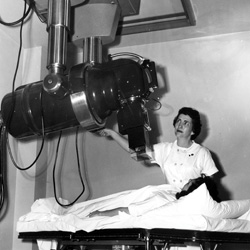The end of the 19th century spawned a new age of medical advances, including the Joseph Lister method of surgery, which motivated three Peoria physicians to found Cottage Hospital, known today as Proctor Hospital.
It was a time of horse-drawn streetcars and passenger trains. It was a time of hard, proud work in plow factories and brickyards, breweries and distilleries, pottery works and flour mills. It was a time of parlors and carriage houses, of hand-written letters and telegrams. It was also a time of typhoid, cholera, smallpox, diphtheria and tuberculosis, with people too often relying on ineffective home remedies and worthless patented miracle cures. Surgery was dangerously crude and kept largely to accidents, infections and amputations. Mortality rates reached as high as 70 percent. It was the late 1800s, a period when medicine was beginning to make hopeful advances and more effective treatments were being discovered. The Joseph Lister method of surgery was one of those new developments.
The Lister Method
Based on experiments by French scientist Louis Pasteur, an English surgeon named Joseph Lister found that it was not exposure to air that caused infection as commonly believed, but exposure to germs in the air. He developed an antiseptic carbolic acid spray that prevented airborne germs from invading surgical incisions. Also advised was sterilization of instruments, the scrupulous cleansing of hands, and the wearing of caps and gowns during surgery.
Not all medical authorities were convinced of the basic principle of airborne germs, and they remained skeptical of the Lister method. Others were eager to recognize its promise, foreseeing the dramatic impact antiseptic surgery would have on medicine and the quality of life. Three of those men were Peoria physicians: Drs. O.B. Will, Thomas McIlvaine and John Hamilton.
Determination Prevails
On a trip abroad in the early 1880s, Dr. McIlvaine acquired Dr. Lister’s carbolic acid spray and returned with it to Peoria. Together with his colleagues, the three men attempted to use the Lister technique in surgery at a local hospital, but failed. It was considered a fad by some authorities, and therefore unacceptable. The determination of Drs. Hamilton, Will and McIlvaine to practice antiseptic surgery, which they believed would greatly improve medical care in the community, drove them to establish Cottage Hospital in 1882. That same year, the first antiseptic surgery in central Illinois was performed there.
Drs. Will and McIlvaine operated, while Dr. Hamilton administered anesthesia. The procedure involved the opening of a female patient’s abdominal cavity, which was then a rare operation. The surgery proved successful to both the life and health of the patient. In 1934, Dr. J. H. Bacon stated that this operation placed Peoria ahead of many cities across the United States and Europe in medical science history.
The original Cottage Hospital building had been a 15-room frame house. After acquiring the property at Second Avenue and Fisher Street, the three doctors converted it into a 50-bed, nonsectarian home for the sick. Almost immediately, there was a need for additional space.
 A Generous Benefactor
A Generous Benefactor
Originally created as a private enterprise, the man who guided the formation of the nonprofit organization that would support the hospital was John C. Proctor. He was also a generous benefactor of the first expansion of Cottage Hospital, having added a brick wing to the original frame structure in 1893 to accommodate the community’s growing medical needs. But growth continued, and Mr. Proctor was again the principal donor when the original frame building was torn down around 1900 and replaced by a four-story, 150-bed hospital.
The new Cottage Hospital opened on February 3, 1902. It featured the incandescent system of electric lighting, a dispensary, laboratory, three well-equipped operating rooms, a department for prospective mothers and the most scientific plumbing that money could buy. Upon the death of John C. Proctor in 1907—in gratitude for his generosity and out of respect for his dedication—the hospital was renamed the John C. Proctor Hospital.
Medical science continued to make advances, and Proctor Hospital progressed right along with it. Yet as we acquired new technology and added new departments, bed capacity had to be sacrificed to provide space for critical services. The once 150-bed capacity had shrunk to 115 beds by the early 1950s. In response to this shortage of space, Proctor’s Board of Trustees commissioned a comprehensive study to evaluate options to alleviate current and future hospital inadequacies.
The Modern Era
In 1954, the study urged that a new and considerably larger hospital be constructed— preferably in the north or northwest section of Peoria, where the population was shifting. Architectural plans for the new Proctor Community Hospital, renamed in 1954, were revealed the following year. The facility would provide for a minimum of 150 beds and cost just over $3 million. With the completion of the new Proctor Community Hospital in April 1959, the modern era had begun.
Today, Proctor Health Care is a vibrant and compassionate leader in the regional medical community, where patient safety is the highest priority. The Hospital provides complete heart and vascular care, inpatient and outpatient surgical services, women’s and senior health services, and an internationally recognized addiction treatment program. It is also home to some of the latest advanced technologies. Other services include a comprehensive orthopedic unit that specializes in total joint replacement, a dedicated skilled nursing center, rehabilitation services, home care and medical equipment. In addition, Proctor First Care and Proctor Medical Group offices offer personalized care throughout the area. iBi
For more information visit proctor.org or find Proctor Health Care on Facebook.


